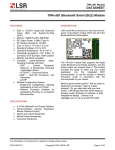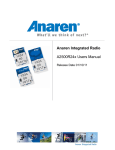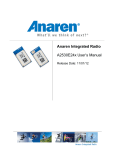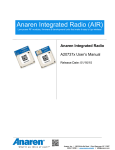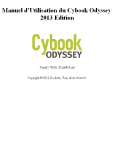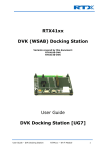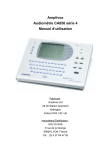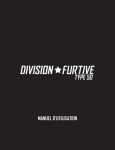Download RTX4100_Application_Note_ Regulatory_Approvals_AN4
Transcript
RTX4100 RTX4140 Wi-Fi Modules Application note AN4 Regulatory Approvals Application note – Regulatory Approvals RTX4100/RTX4140 – Wi-Fi Module 1 CONTENT 1 2 Introduction ............................................................................................................................................ 3 1.1 General Description .................................................................................................................................. 3 1.2 Document History ..................................................................................................................................... 3 1.3 Document References .............................................................................................................................. 3 Regulated Approvals ............................................................................................................................... 4 2.1 USA (Federal Communications Commission, FCC, ) ............................................................................ 4 2.1.1 FCC Labeling Requirements ........................................................................................................... 5 2.1.2 End User Manual........................................................................................................................... 6 2.1.3 RF Exposure ................................................................................................................................... 6 2.2 Canada (Industry Canada, IC).................................................................................................................... 7 2.2.1 2.3 Canada (Industrie Canada, IC), Français ................................................................................................... 8 2.3.1 2.4 ) .................................................................................................... 9 ETSI Documentation Requirements ............................................................................................. 10 2.4.1.1 Modular Approval .............................................................................................................. 10 2.4.1.2 End Host Approval .............................................................................................................. 11 Japan (Giteki, 2.5.1 2.6 Exigences d’étiquetage IC ............................................................................................................. 8 Europe (Conformité Européenne, 2.4.1 2.5 IC labeling requirements ............................................................................................................... 7 )................................................................................................................................... 12 Labeling requirements ................................................................................................................ 12 Korea (KCC, ) ....................................................................................................................................... 13 2.6.1 Labeling requirements ................................................................................................................ 13 2.6.2 End User Manual......................................................................................................................... 13 2.7 Approved antennas ................................................................................................................................ 14 Application note – Regulatory Approvals RTX4100/RTX4140 – Wi-Fi Module 2 1 Introduction 1.1 General Description The RTX4100/RTX4140 Wi-Fi Modules are small form-factor, single stream, 802.11b/g/n Wi-Fi modules with on-board low power application processor. It is targeted at applications that send infrequent data packets over the network. Typically, these 802.11 applications will place a higher priority on system cost, power consumption, ease of use, and fast wake-up times as compared to high throughput. The RTX4100/RTX4140 have received regulatory approvals for modular devices in the United States (FCC), Canada (IC), Japan (Giteki), and Korea (KCC), as well as regulatory approvals in Europe (ETSI). The modular approval allows the integrator to place the RTX4100/RTX4140 using either the internal antenna or an approved antenna inside a finished product without having to perform costly regulatory testing. The requirements the integrator must fulfil to use modules without additional testing are listed in this Application Note. 1.2 Document History V1.0 Official release PEW 2012-08-28 V1.1 CE update PEW 2012-10-29 V1.2 Giteki and RTX4140 update PEW 2013-03-12 V1.3 Japanese Construction Certification Number added PEW 2013-09-13 V1.4 KCC certification added + statement EN300 328 PEW 2015-03-17 V1.5 CE approval updated to newest specs + reordering PEW 2015-08-13 Disclaimer: This document can be subject to change without prior notice. 1.3 Document References There are no sources in the current document. Application note – Regulatory Approvals RTX4100/RTX4140 – Wi-Fi Module 3 2 Regulated Approvals The RTX4100/RTX4140 has been designed to meet most national regulations for worldwide ISM-band use. In particular the radio modules have been certified to the following standards. FCC Part 15.247 (US) IC (Canada) o RSS Gen (CNR-Gen), Issue 3 o RSS-210 (CNR-210), Issue 8 ETSI (EU) o EN 300 328 (V1.9.1) o EN 301 489-01 (V1.9.2) o EN 301 489-17 (V2.2.1) Giteki (Japan) o ARIB STD T66 (V3.6) o ARIB RCR STD-33 (V5.4) KCC (Korea) o o MSIP Notification 2013-157, Rules on Radio Equipment KCC Notice 2012-101, Article 98, Korea Wireless Requirement 2.1 USA (Federal Communications Commission, FCC, ) The RTX4100/RTX4140, with integrated antenna, as well as used with the antennas listed in Section 2.7 Table 1, have been tested to comply with FCC CFR47 Part 15 sub-part C “Intentional Radiators”. The devices meet the requirements for modular transmitter approval as detailed in FCC Part 15 Section 15.212 Modular Transmitters. The RTX4100/RTX4140 modules can be integrated into a finished product without obtaining subsequent FCC approvals. The RTX4100/RTX4140 modules complies with part 15 of the FCC rules. Operation is subject to the following two conditions: (1) this device may not cause harmful interference, and (2) this device must accept any interference received, including interference that may cause undesired operation. Changes or modifications to the equipment not expressly approved by the party responsible for compliance could void the user's authority to operate the equipment. Both the RTX4100 and the RTX4140 have the same FCC ID. RTX A/S FCC ID: S9J4100 Application note – Regulatory Approvals RTX4100/RTX4140 – Wi-Fi Module 4 According to FCC Part 15 section 15.204(a4) any antenna that is of the same type and of equal or less directional gain as an antenna that is authorized with the intentional radiator may be marketed with, and used with, that intentional radiator. No retesting of this system configuration is required. See listing of approved antennas in Section 2.7, Table 1. When integrating either the RTX4100 or the RTX4140 into a finished product with mains supply additional approval is required according to FCC Part 15 section 15.207(a). The RTX4100/RTX4140 does comply to the FCC Part 15 section 15.207(c) for battery powered omitting FCC Part 15 section 15.207(a). FCC Part 15 Section 15.207(a) states: “Except as shown in paragraphs (b) and (c) of this section, for an intentional radiator that is designed to be connected to the public utility (AC) power line, the radio frequency voltage that is conducted back onto the AC power line on any frequency or frequencies, within the band 150 kHz to 30 MHz, shall not exceed the limits in the following table, as measured using a 50 μH/50 ohms line impedance stabilization network (LISN). Compliance with the provisions of this paragraph shall be based on the measurement of the radio frequency voltage between each power line and ground at the power terminal. The lower limit applies at the boundary between the frequency ranges.” Table and other paragraphs refered to in quote can be found in FCC Part 15. 2.1.1 FCC Labeling Requirements The RTX4100/RTX4140 modules have been labeled with their own FCC ID number and if the FCC ID is not visible when the module is installed inside another device, then the outside of the finished product into which the module is installed must also display a label referring to the enclosed module. This exterior label can use wording such as the following: Contains Transmitter Module FCC ID: S9J4100 -orContains FCC ID: S9J4100 This device complies with the Part 15 of the FCC Rules. (1) this device may not cause harmful interference, and (2) this device must accept any interference received, including interference that may cause undesired operation. Application note – Regulatory Approvals RTX4100/RTX4140 – Wi-Fi Module 5 2.1.2 End User Manual The end user manual should include the following statement: This equipment has been tested and found to comply with the limits for a Class B digital device, pursuant to part 15 of the FCC Rules. These limits are designed to provide reasonable protection against harmful interference in a residential installation. This equipment generates, uses and can radiate radio frequency energy and, if not installed and used in accordance with the instructions, may cause harmful interference to radio communications. However, there is no guarantee that interference will not occur in a particular installation. If this equipment does cause harmful interference to radio or television reception, which can be determined by turning the equipment off and on, the user is encouraged to try to correct the interference by one or more of the following measures: Reorient or relocate the receiving antenna. Increase the separation between the equipment and receiver. Connect the equipment into an outlet on a circuit different from that to which the receiver is connected. Consult the dealer or an experienced radio/TV technician for help. 2.1.3 RF Exposure This device complies with FCC RF radiation exposure limits set forth for an uncontrolled environment. The antenna used for this transmitter must be installed to provide a separation distance of at least 20 cm from all persons and must not be co-located or operating in conjunction with any other antenna or transmitter. All transmitters regulated by the FCC must comply with RF exposure requirements. OET Bulletin 65 “Evaluating Compliance with FCC Guidelines for Human Exposure to Radio Frequency Electromagnetic Fields” provides assistance in determining whether proposed or existing transmitting facilities, operations or devices comply with limits for human exposure to Radio Frequency (RF) fields adopted by the Federal Communications Commission (FCC). The bulletin offers guidelines and suggestions for evaluating compliance. If appropriate, compliance with exposure guidelines for mobile and unlicensed devices can be accomplished by the use of warning labels and by providing end users with information concerning minimum separation distances from transmitting structures and proper installation of antennas. The following statement must be included as a CAUTION statement in manuals and OEM products to alert end users of FCC RF Exposure compliance: To satisfy FCC RF Exposure requirements for mobile and base station transmission devices, a separation distance of 20 cm or more should be maintained between the antenna of this device and persons during operation. To ensure compliance, operation at closer than this distance is not recommended. The antenna(s) used for this transmitter must not be co-located or operating in conjunction with any other antenna or transmitter. If the RTX4100/RTX4140 module is used in a portable application (antenna is less than 20 cm from persons during operation), the end user is responsible for performing Specific Absorption Rate (SAR) testing in accordance with FCC rules 2.1091. Application note – Regulatory Approvals RTX4100/RTX4140 – Wi-Fi Module 6 2.2 Canada (Industry Canada, IC) The RTX4100/RTX4140 modules have been certified for use in Canada under Industry Canada (IC) Radio Standards Specification (RSS) RSS-210 and RSS-Gen. This Class B digital apparatus complies with Canadian ICES-003. This device complies with Industry Canada licence-exempt RSS standard(s). Operation is subject to the following two conditions: (1) this device may not cause interference, and (2) this device must accept any interference, including interference that may cause undesired operation of the device. From section 3.2 RSS-Gen, Issue 3, December 2010, Modular Approval for Category I Equipment or Category II Equipment: Modular approval permits the installation of the same module in a host device or multiple host devices without the need to recertify the device. Equipment certification for a modular device may be sought for either Category I equipment or Category II equipment. Transmitters designed as modules for the installation in a host device may obtain equipment certification as a modular device provided that the applicable RSS is met and the following conditions in this section are met. 2.2.1 IC labeling requirements The host device shall be properly labeled to identify the modules within the host device. The Industry Canada certification label of a module shall be clearly visible at all times when installed in the host device, otherwise the host device must be labeled to display the Industry Canada certification number of the module, preceded by the words “Contains transmitter module”, or the word “Contains”, or similar wording expressing the same meaning, as follows: Label: Contains IC: 4979A-4100 The IC certification number is equal for both RTX4100 and RTX4140. For more information see: Industry Canada http://www.ic.gc.ca/ Application note – Regulatory Approvals RTX4100/RTX4140 – Wi-Fi Module 7 2.3 Canada (Industrie Canada, IC), Français Le module RTX4100/RTX4140 a été certifié pour un usage au Canada avec les Cahier des charges sur les normes radioélectriques (CNR) pour l’Industrie Canada (IC) CNR-210 et CNR-Gen. Cet appareil numérique de la classe B est conforme à la norme NMB-003 du Canada. Le présent appareil est conforme aux CNR d’Industrie Canada applicables aux appareils radio exempts de licence. L’exploitation est autorisée aux deux conditions suivantes: (1) l’appareil ne doit pas produire de brouillage, et (2) l’utilasteur de l’appereil doit accepter tout brouillage radioélectrique subi, même si le brouillage est susceptible d’en compromettre le fonctionnement. Tiré de la section 3.2 CNR-Gen, 3ème edition, de Décembre 2010, l’approbation modulaire de matériel de catégorie I ou de matériel de catégorie II: L’approbation modulaire permet l’installation du même module dans un ou plusieurs appareils hôtes sans qu’il soit nécessaire d’obtenir une nouvelle certification de l’appareil. La certification de matériel à l’egard d’un appareil modulaire peut être demandée dans le cas du matériel du catégorie I ou du matériel du catégorie II. Les émetteurs conçus comme modules en vue de leur installation dans un appareil hôte peuvent obtenir une certification de matériel comme dispotifs modulaires, pourvu que le CNR applicable soit respecté et que les conditions de la présente section qui suivent soient respectées. 2.3.1 Exigences d’étiquetage IC L'appareil hôte doit être étiqueté comme il faut pour permettre l’identification des modules qui s’y trouvent. L’étiquette de certification d’Industrie Canada d’un module donné doit être posée sur l’appereil hôte à un endoit bien en vue en tout temps. En l’absence d’étiquette, l’appareil hôte doit porter une étiquette donnant le numéro de certification du module d’Industrie Canada, précédé des mots «Contient un module d’émission», du mot «Contient» ou d’une formulation similaire exprimant le même sens, comme suit: Label: Contient IC: 4979A-4100 Le numéro de certification IC est égale pour les deux RTX4100 et RTX4140. Pour plus d’information, voir: Industry Canada http://www.ic.gc.ca/ Application note – Regulatory Approvals RTX4100/RTX4140 – Wi-Fi Module 8 2.4 Europe (Conformité Européenne, ) The RTX4100/RTX4140 modules have been certified for use in European countries. The following testing has been completed: Test standard ETSI EN 300 328 V1.9.1 (2015-02) Maximum Transmit Power Power Spectral Density Occupied Bandwidth Spectrum Sharing Mechanism (Adaptivity) Unwanted Emissions Test standards ETSI EN 301 489-1 V1.9.2, ETSI EN 301 489-17 V2.2.1, and EN61000-4-3(2008) Ed 3.1. Radiated Emissions Radiated RF Susceptibility A platform release of version 1.6.0.60 or newer is required to comply to above standard versions. Older platform releases are complient to EN 300 328 V1.7.1, which is obsolete for new products entering the market after 1st January 2015. The end user is responsible for ensuring compliance with harmonized frequencies and labeling requirements, for each country the end device is marketed and sold. According to ETSI EN 300 328 V1.9.1 the Maximum Effective Radiated Power shall not exceed 100mW (20dBm) for any combination of powerlevel and intended antenna assembly. To comply to this, an external antenna with a gain less than 4dBi shall be used. Approved antennas are listed in Section 2.7, Table 1. The Spectrum Sharing Mechanism used in RTX4100/RTX4140 is, before transmission of a burst the system performs a Clear Channel Assessment (CCA) check using “energy detect”. If the operating channel is found clear the equipment transmits immediately. When the operating channel is occupied then an extended CCA is performed to find an available channel. When integrating the RTX4100/RTX4140 into a finished product additional ETSI approval measurements regarding ESD are required according to ETSI EN 301 489-1, EN 301 48917, and EN 61000-4-2. As the RTX4100/RTX4140 is a module without housings, ESD testing has been omitted on the module level. A helpful document that can be used as a starting point in understanding the use of short range devices (SRD) in Europe is the European Radio Communication Committee (ERC) Recommendation 70-03E, downloadable from the European Radio Communications Office (ECO) document database http://www.ecodocdb.dk/ (select ‘ECC Recommendations’ and scroll down to ‘ERC/REC 70-03 Short Range Devices (SRD)’). Application note – Regulatory Approvals RTX4100/RTX4140 – Wi-Fi Module 9 For more information see: Internal Market, Industry, Entrepreneurship and SMEs http://ec.europa.eu/growth/index_en.htm European Conference of Postal and Telecommunications Administrations (CEPT) http://www.cept.org/ European Telecommunications Standards Institute (ETSI) http://www.etsi.org/ European Committee for Electrotechnical Standardization (CENELEC) http://www.cenelec.eu/ 2.4.1 ETSI Documentation Requirements The RTX4100/RTX4140 modules have been designed for quick and easy integration into OEM or end-user products, and have been tested at an independent accredited test laboratory to demonstrate compliance to the ETSI specifications at a modular level. The following sections describes the documentation required when integrating a RTX4100/RTX4140 module into an OEM or end-user product. 2.4.1.1 Modular Approval Applies to OEM modules intended for further integration into and end-user product. Could require the following tests to demonstrate compliance. RF tests: Confirms Radio Module meets emmissions specifications (“intentional Radiator”) - EN 300 328 Electromagnetic compatibility and Radio spectrum Matters (ERM) Immunity tests: (per EN 301 489-17) Confirms Radio Module stays within specifications when influenced externally: - EN 61000-4-2 ESD - EN 61000-4-3 Radiated Immunity Other Tests: (dependent on user scenarios) - EN 62311 Human RF Exposure - EN 60950-1 Safety Evaluation Low Voltage Directive (SELV) Above tests in italic have been performed by an accredited test laboratory. The RTX’s test reports of these tests may be used to satisfy the ETSI documentation requirements (provided the OEM module antenna does not exceed a gain of 4,0dBi), and therefore do not have to be redone. Copies of the reports can be obtained by contacting RTX. The remaining tests are normally a fast and easy procedure almost identical to any compliance test needed for non-wireless electronic modules. Application note – Regulatory Approvals RTX4100/RTX4140 – Wi-Fi Module 10 2.4.1.2 End Host Approval Applies to end-user products. Requires the following minimum tests to demonstrate compliance: RF tests: For use of RTX’s report, see comments in section 2.4.1.1 Modular Approval. Electromagnetic Compatibility (EMC): (per EN 300 328) Required for all products (radio module or not), confirms end-user product does not unintentionally violate emisionss guidelines (“Unintentional Radiator”). Since the actual specifications vary depending upon end-user product type, contact a test laboratory for further information. - Raditaed Emissions: Required for both battery and AC Mains powered products. - Conducted Emissions: Required for AC Mains powered products only. Immunity Tests: (per EN 301 489-17) Radio Module stays within specifications when influenced externally: - EN 61000-4-4 EFT - EN 61000-4-5 Surge - EN 61000-4-6 Conducted Immunity - EN61000-4-8 Magnetic Immunity (if the product is susceptible to magnetic fields) - EN61000-4-11 Voltage Dips & Interupts Similar to section 2.4.1.1 the needed tests to supplement what has already been done by RTX are normally a fast and easy procedure almost identical to any compliance test needed for non-wireless electronic products. Application note – Regulatory Approvals RTX4100/RTX4140 – Wi-Fi Module 11 2.5 Japan (Giteki, ) The RX4100/RTX4140 module has been certified for use in Japan. The following testing has been completed according to Low Power WiFi devices standards: ARIB STD T66, Second Generation Low Power Data Communication System/Wireless LAN System, Version 3.6 ARIB RCR STD-33, Low Power Data Communications System/Wireless LAN System, Version 5.4 Provided that the OEM module antenna does not exceed a gain of 3,0dBi a new certification is not to be performed. Radiated power tests of the RTX4100/RTX4140 have been performed by an accredited test laboratory and he RTX’s test reports of these tests may be used to satisfy the documentation requirements. Changes or modifications to the equipment not expressly approved by the party responsible for compliance could void the user's authority to operate the equipment. Both the RTX4100 and the RTX4140 have the same Construction Certification Number. R 008-130059 2.5.1 Labeling requirements The end user is responsible for ensuring compliance with The Association of Radio Industries and Businesses (ARIB) frequencies and labelling requirements for use in Japan. For more information of how to label the host product refer to ARIB STD T66, Annex 2: ARIB STD T66, V3.6, Japanese version http://www.arib.or.jp/english/html/overview/doc/1-STD-T66v3_6.pdf ARIB STD T66, V2.1, Latest translated version in English http://www.arib.or.jp/english/html/overview/doc/5-STD-T66v2_1-E.pdf Application note – Regulatory Approvals RTX4100/RTX4140 – Wi-Fi Module 12 2.6 Korea (KCC, ) The RTX4100 and RTX4140 module has been certified for the Korean market. The following testing has been conducted by a Korean accredited test lab according to the following standards: MSIP Notification 2013-157, Rules on Radio Equipment KCC Notice 2012-101, Article 98, Korea Wireless Requirement Both the RTX4100 and the RTX4140 have the same MSIP ID RTX A/S MSIP-CRM-R2X-4100 2.6.1 Labeling requirements The host device shall be properly labeled to identify the modules within the host according to the KCC requirements. The RTX4100 and RTX4140 modules are themselves labelled with the KCC logo and the MSIP ID. The end product containing the RTX4100 or RTX4140 module should also be clearly labelled with: KCC logo at least 5mm in height. End product MSIP ID (MSIP-xxx-xxx-xxxxxxxxxx) RTX4100 MSIP ID This caution statement “당해 무선설비는 운용중 전파혼신 가능성이 있음” shall be marked at a conspicuous location of the equipment (fx label). Translation of “당해 무선설비는 운용중 전파혼신 가능성이 있음” is: This device may cause radio interference during operation. 2.6.2 End User Manual The end product manufacturer shall include sufficient information in the user manual or in an application note, that this radio equipment has a probability of interference with other radio equipment. Therefore it is prohibited to use this radio equipment where it can interfere with life safety related services, to avoid malfunction of such devices. Following phrase in Korean can be used: “해당 무선설비는 전파혼신 가능성이 있으므로 인명안전과 관련된 서비스는 할 수 없음” Translates into: The service related to human saftety is not allowed because this device may have the possibility of radio interference. In the end user manual the following should also be stated if it is not placed on the product label: 1. 상 호 명: Applicant company name 2. 기자재의 명칭 (모델명): Equipment name (Model number) 3. 제조연월: Manufacturing date (Month and Year) 4. 제 조 자/제 조 국: Manufacturer / country of origin Application note – Regulatory Approvals RTX4100/RTX4140 – Wi-Fi Module 13 One of the following Korean statements shall be inserted into the End Product User Manual depending on the category of the End Product Class A: (Product for commercial use) A급 기기 (업무용 방송통신기자재) 이 기기는 업무용(A급)으로 전자파적합기기로 서 판매자 또는 사용자는 이 점을 주의하시기 바라며, 가정외의 지역에서 사용하는 것을 목 적으로 합니다. ClassB: (Product for residential use) B급 기기 (가정용 방송통신기자재) 이 기기는 가정용(B급)으로 전자파적합기기로 서 주로 가정에서 사용하는 것을 목적으로 하 며, 모든 지역에서 사용할 수 있습니다. 2.7 Approved antennas FCC and CE approved antennas are listed in below Table 1. Table 1 Approved Antennas Item 1 2 3 4 Part Number Internal antenna GW17.07.0250E PC17.07.0070A 2118059-1 Manufacturer RTX Taoglas Taoglas TE Connectivity Application note – Regulatory Approvals Type Internal PCB antenna Dipole External PCB antenna Single Band Antenna Gain (dBi) 1.9 2.7 0.9 4.0 RTX4100/RTX4140 – Wi-Fi Module 14














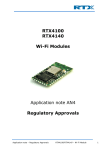

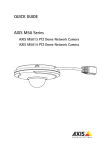



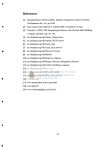
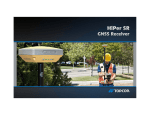
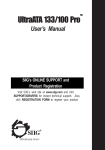
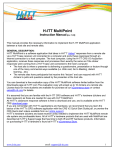
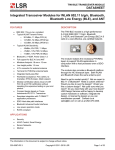
![RTX4100 Wi-Fi Module User Guide WSAB Docking Station [UG7]](http://vs1.manualzilla.com/store/data/006886306_1-a44ab0f4a9043ebd3739376f36e6f1b4-150x150.png)
